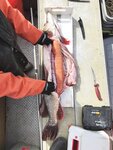

From the late 1800’s until the middle of the 20th century there was a bounty on wolves in the Midwest and Western United States. Both individual and government hunters used any means necessary to kill these animals, deemed a dangerous nuisance to livestock. By the time this program ended, wolves were essentially exterminated from the lower 48 states. It wasn’t until 1995 when wolves were reintroduced to Yellowstone National Park that their numbers began to come back and today, we are seeing healthy populations of these animals in several states.
The relationship between humans and northern pike is a bit more complicated. These torpedo shaped fish are green in color with white spots and a white belly. They can grow to over 50 inches long and weigh over 45 pounds, though an average sized pike measures between 16 and 22 inches in length. Pike are ambush predators and feed on other fish as well as frogs and even ducklings, waiting in weeds or behind rocks and logs and then lunging forward to attack their prey. With a mouthful of long, sharp teeth they have garnered themselves the nickname, “water wolves”.
Unlike the land based wolf, there was no historical dislike for these fish which are found in the northern tier of the United States as well as in Canada and Alaska. They are a sought-after catch because of their size and hard fighting ability. They also taste good though a y-bone in their body makes them more difficult to clean and fillet than walleye or trout. In the winter anglers will target these fish through the ice while in the spring they are often caught in places like Lake Coeur d’ Alene fishing bait under a slip bobber. They can also be caught from spring thru fall throughout their native range using large spoons. Casting red and white Dardevle spoons and yellow spoons with red diamonds on them (known as a Five of Diamonds) are traditional offerings.
In Washington State, northern pike are found in Long Lake, the Pend Oreille River and Lake Roosevelt, having migrated there from Lake Coeur d’ Alene in Idaho and Montana’s Clark Fork River. The fish are not welcome in the Evergreen State. Both the Washington Department of Fish and Wildlife as well as the Colville Tribes are extremely concerned about their impact to native populations in these waterways such as redband trout, sturgeon, burbot and kokanee salmon. Fisheries managers also want to ensure northern pike do not get into the mainstem Columbia River below Grand Coulee Dam where they could wreak havoc with native salmon and steelhead populations.
Since 2015, the Colville Tribes, Spokane Tribe and Washington Department of Fish and Wildlife have been working hard to eradicate pike from these waterways. They have had good success in reducing a burgeoning population of these fish in the Pend Oreille River and since 2015 have removed over 19,100 fish from Lake Roosevelt. The primary method the Colville Tribes use to catch these pike is with gill nets but they have found this method alone is not enough. That’s why a bounty program has been introduced at Lake Roosevelt for recreational anglers.
Anglers who catch northern pike (of any size) can turn in the head of the fish at designated drop off sites around Lake Roosevelt and be paid $10 for each fish head turned in.
Anglers can drop off their pike heads at Noisy Waters Gas Station, Kettle Falls boat launch, Hunters boat launch, Fort Spokane boat launch, or at the Inchelium Fish and Wildlife office. In 2022, anglers turned in 125 heads and were paid $1,250.
In an effort to increase the number of fish caught by recreational anglers for this program, the Colville Tribes Fish and Wildlife Department has published a map showing pike hot spots around the lake. Some of these hotspots are found at the mouth of the Kettle River, near Evans, on the eastern end of the lake near Noisy Waters, and at the mouth of the Colville River south of Kettle Falls. Additional places worth fishing can be found south of Gifford and on either side of the reservoir near Hunters.
Here are the rules if you want to participate in the Northern Pike Bounty Program:
You must be 17 years of age or older to participate in the program.
Anglers must completely fill out the tag information at the designated drop off area. Fish heads must be placed in a freezer bag with the label and dropped into the freezer or brought to the Inchelium Fish and Wildlife office.
Fish heads must be in good condition and clearly identifiable. Unidentifiable heads will not be accepted or awarded.
Fish must be caught in the main stem Columbia River from Wells Dam upstream to the Canadian border, the Spokane River upstream to Little Falls, the Kettle River, or the Okanogan River.
There are no size restrictions on northern pike.
Anglers must adhere to all applicable state/tribal fishing regulations for the area in which you fish. Contact your local state or tribal agency for license requirements and current fishing regulations.
Please allow 2 to 3 weeks to receive your reward. Additional information about the program can be found at www.cct-fnw.com/northern-pike.
John Kruse – www.northwesternoutdoors.com and www.americaoutdoorsradio.com
Comments
No comments on this item Please log in to comment by clicking here